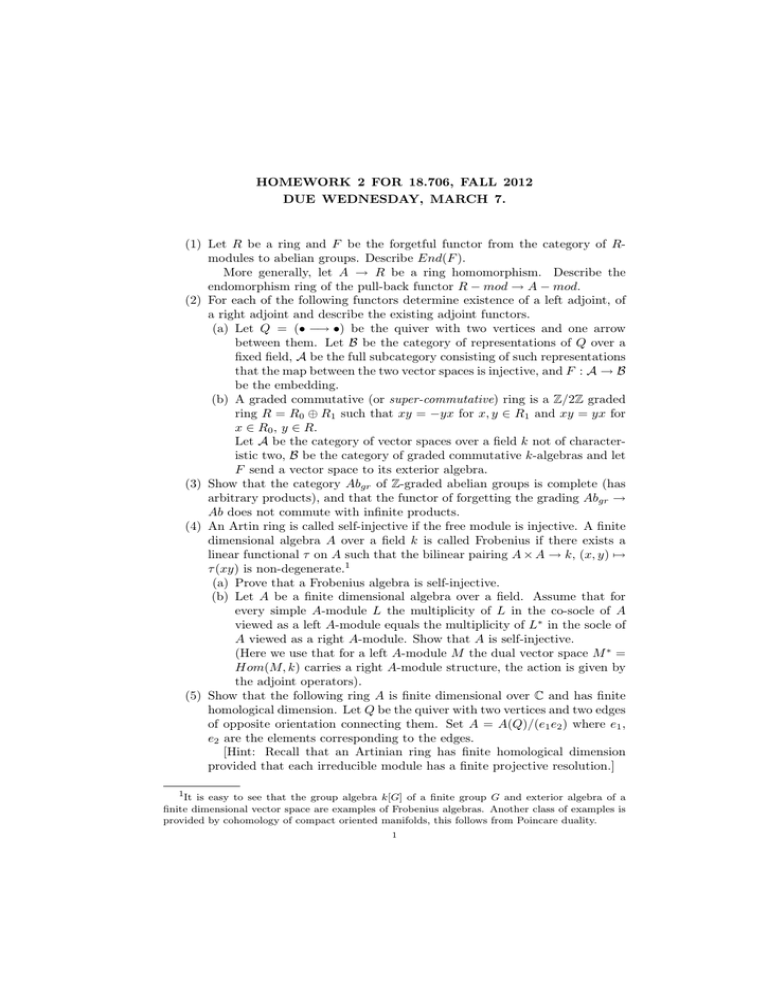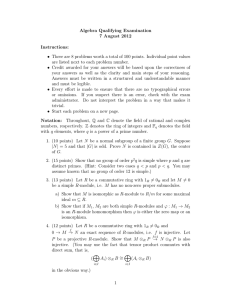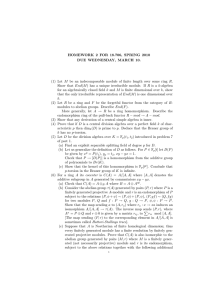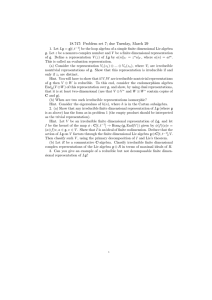HOMEWORK 2 FOR 18.706, FALL 2012 DUE WEDNESDAY, MARCH 7.
advertisement

HOMEWORK 2 FOR 18.706, FALL 2012 DUE WEDNESDAY, MARCH 7. (1) Let R be a ring and F be the forgetful functor from the category of Rmodules to abelian groups. Describe End(F ). More generally, let A → R be a ring homomorphism. Describe the endomorphism ring of the pull-back functor R − mod → A − mod. (2) For each of the following functors determine existence of a left adjoint, of a right adjoint and describe the existing adjoint functors. (a) Let Q = (• −→ •) be the quiver with two vertices and one arrow between them. Let B be the category of representations of Q over a fixed field, A be the full subcategory consisting of such representations that the map between the two vector spaces is injective, and F : A → B be the embedding. (b) A graded commutative (or super-commutative) ring is a Z/2Z graded ring R = R0 ⊕ R1 such that xy = −yx for x, y ∈ R1 and xy = yx for x ∈ R0 , y ∈ R. Let A be the category of vector spaces over a field k not of characteristic two, B be the category of graded commutative k-algebras and let F send a vector space to its exterior algebra. (3) Show that the category Abgr of Z-graded abelian groups is complete (has arbitrary products), and that the functor of forgetting the grading Abgr → Ab does not commute with infinite products. (4) An Artin ring is called self-injective if the free module is injective. A finite dimensional algebra A over a field k is called Frobenius if there exists a linear functional τ on A such that the bilinear pairing A × A → k, (x, y) 7→ τ (xy) is non-degenerate.1 (a) Prove that a Frobenius algebra is self-injective. (b) Let A be a finite dimensional algebra over a field. Assume that for every simple A-module L the multiplicity of L in the co-socle of A viewed as a left A-module equals the multiplicity of L∗ in the socle of A viewed as a right A-module. Show that A is self-injective. (Here we use that for a left A-module M the dual vector space M ∗ = Hom(M, k) carries a right A-module structure, the action is given by the adjoint operators). (5) Show that the following ring A is finite dimensional over C and has finite homological dimension. Let Q be the quiver with two vertices and two edges of opposite orientation connecting them. Set A = A(Q)/(e1 e2 ) where e1 , e2 are the elements corresponding to the edges. [Hint: Recall that an Artinian ring has finite homological dimension provided that each irreducible module has a finite projective resolution.] 1It is easy to see that the group algebra k[G] of a finite group G and exterior algebra of a finite dimensional vector space are examples of Frobenius algebras. Another class of examples is provided by cohomology of compact oriented manifolds, this follows from Poincare duality. 1







